a Digital Exhibition by the Michigan State University
Science Communication Organization
Share this Exhibition


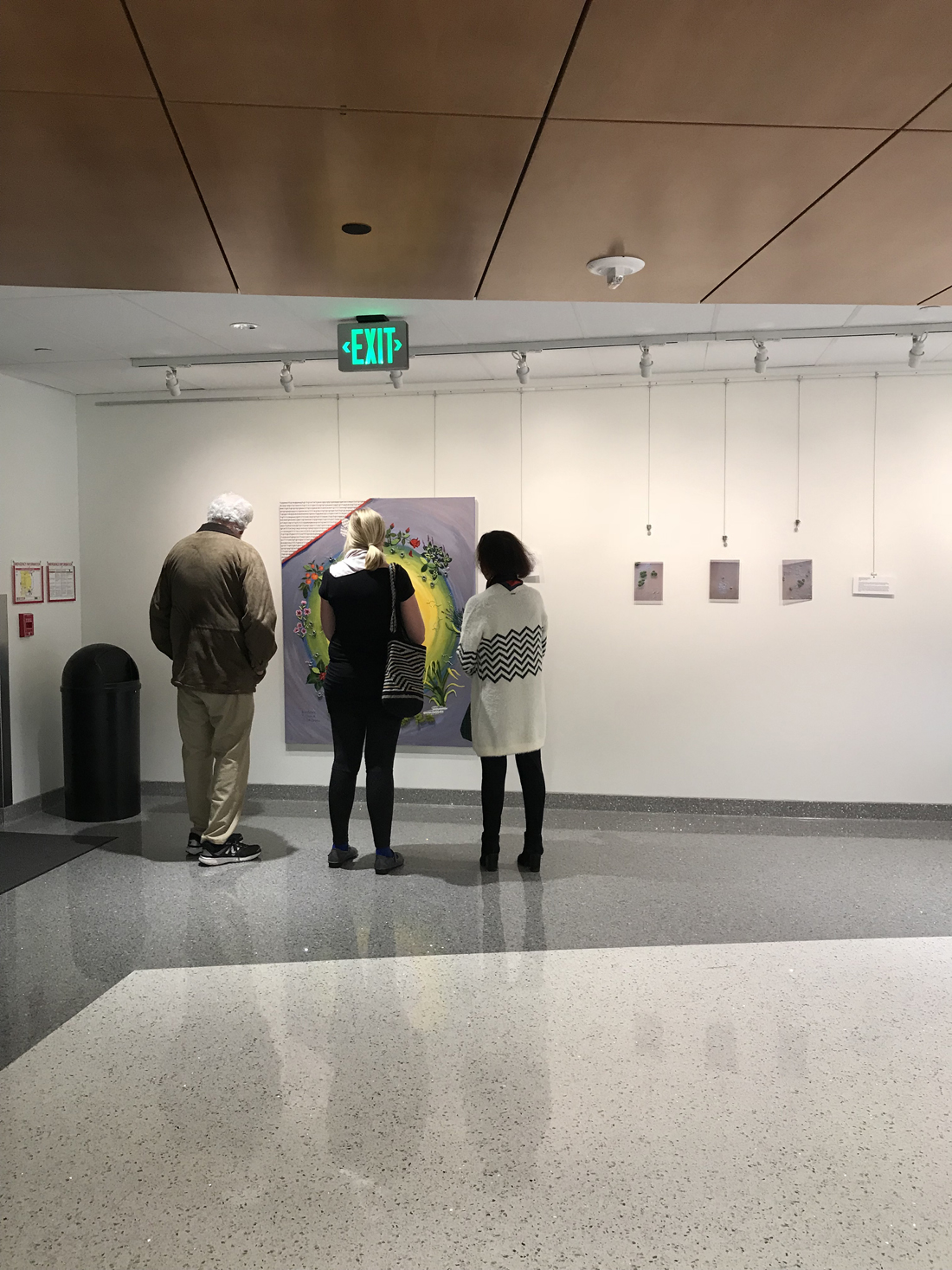





 SciArt Creators // Joelyn de Lima & Zoe Beaudry
SciArt Creators // Joelyn de Lima & Zoe BeaudryJoelyn researches the ways that students’ reasoning is influenced by the context in which a prompt is given; particularly when they are asked to reason about human evolution versus the evolution of other animals. Zoe’s artistic practice investigates the ways in which technology is becoming an essential extension of human biology. Contextual Influences on Algorithmic Reasoning uses multiple layers of comparison, opposition, contrast, and potential to creatively illustrate reasoning pathways and draw parallels between the two bodies of work. In this piece, Google Maps becomes the reasoning faculty, and the human is pitted against the insect. A momento mori symbol, the fly is a reminder that though Google may be one of our crowning glories as a species, the flies will probably outlive us.

What was the inspiration behind your artwork?
Joelyn: My research on the way changing the context of a question changes the way students reason about the same concept.
Zoe: Contextual Influences on Algorithmic Reasoning uses multiple layers of comparison, opposition, contrast, and potential to creatively illustrate reasoning pathways and draw parallels between the two bodies of work. In this piece, Google Maps becomes the reasoning faculty, and the human is pitted against the insect. A momento mori symbol, the fly is a reminder that though Google may be one of our crowning glories as a species, the flies will probably outlive us.
Why is science-art important in today’s society?
Joelyn: In today's world increasingly polarising world it is very important to build connections and bridges. Sciart not only brings together the scientists and artists (people who normally do not interact as part of their professional lives), but also brings the science to an audience that is probably missed by all the scientific journals!
Zoe:Art needs groundedness and research like science needs elevation and creativity.
What did you learn from this initiative?
Joelyn: Having to communicate my science in a way that is accessible to a non-scientist.
Zoe: I learned new ways of communicating ideas, and translating data to images.
Joelyn description: I am Joelyn de Lima, a Ph.D. candidate at Michigan State University and I explore how context influences students’ reasoning and representations. I got my Bachelor of Science (Zoology with Biotechnology), Master of Science (Marine Science) and Bachelor of Education degrees from Goa University. Born and brought up in Goa, India, I now split my time between Copenhagen, Denmark and Lansing, Michigan. At heart, I am a passionate adventurer and explorer!
Links: Website
Zoe description: Zoe Beaudry is an oil painter from East Lansing Michigan, with a BA in studio art from Kalamazoo College and and MFA from the Glasgow School of Art.
Links: Instagram
 SciArt Creators // Chelsea Burchett & Morgane Chretien
SciArt Creators // Chelsea Burchett & Morgane ChretienThis piece shows the diversity of the plant microbiome that one cannot normally see with the naked eye. It is essential for microbes, like bacteria and fungi, to colonize plants. There are thousands of symbiotic interactions in the soil, on the surface of plant tissue, and in plant cells that all significantly affect the growth and health of plants. Research is being done to select certain bacterial and fungal strains to alter the microbiome of switchgrass plants to form the most optimal symbiotic interactions, thus, making the production of this plant more sustainable. The "watering" symbolizes the selection of certain microbes and demonstrates their significance to plant growth.
What was the inspiration behind your artwork?
Morgane: I'm inspired by the Great Lakes Bioenergy Research Center and their effort to create sustainable cropping systems as a part of their larger goal to create economical and sustainable biofuels and bioproducts.
Why is science-art important in today’s society?
Morgane: Science-art is important because it helps the nonscience focused people understand scientific concepts in a more approachable way. Scientific journals for example are not written in a way for the general population to follow. Reading the journals can be daunting and one can easily get lost in the jargon and methods. In a time like now with pressing climate change issues, the public needs to understand the science behind it in order to know how pressing of a problem it is. Creating science-art media can make the topics more approachable for people.
What did you learn from this initiative?
Morgane: I learned that people of different academic focuses can work together quite efficiently and create well-rounded products that can reach a wider audience and having a larger impact on society.
Morgane Description: I'm a fourth-year undergraduate studying environmental biology and microbiology. I’m passionate about trying to help solve our world’s climate issues.
Links: LinkedIn
 SciArt Creators // Sara Ayoub
SciArt Creators // Sara AyoubSara Ayoub is a graduate student studying nuclear astrophysics at NSCL/MSU. Through this piece, she combines her two passions into one creative outlet. A massive celestial object based on quasars is represented. A quasar is the bright center of a distant galaxy believed to be powered by a feeding supermassive black hole. As material spirals into the black hole, energy is released with enormous power in the form of electromagnetic radiation.

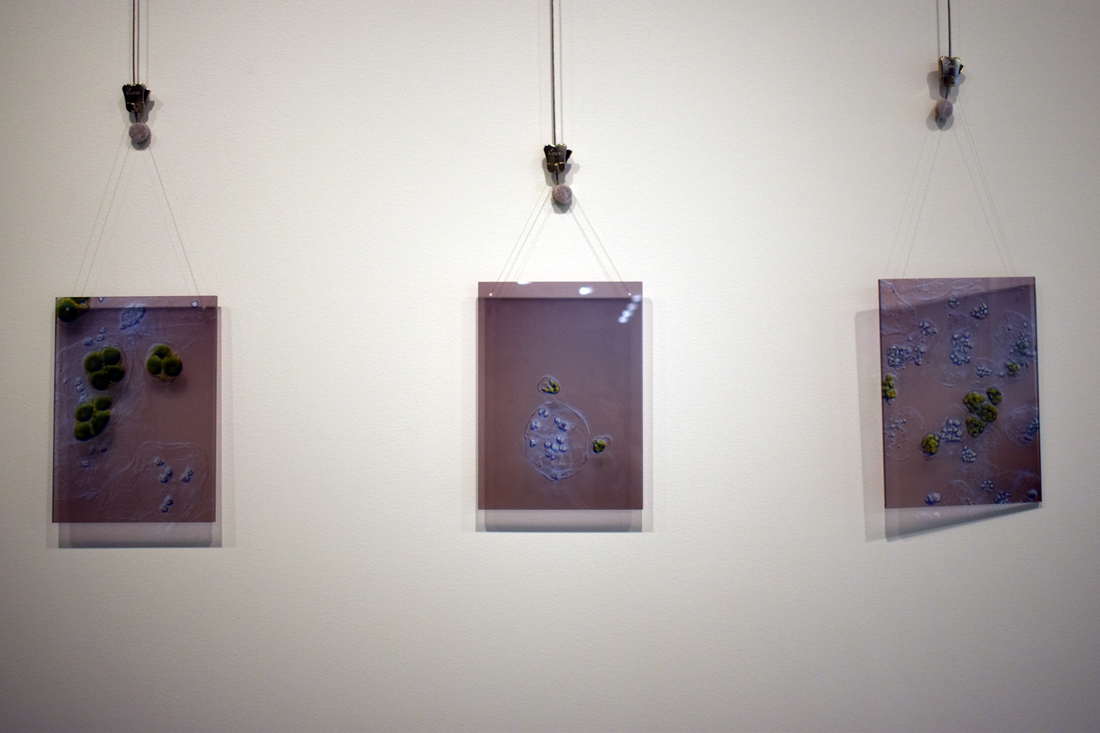 SciArt Creators // Emily Jennings & Jane Kramer
SciArt Creators // Emily Jennings & Jane KramerLike us, plants are made up of billions of cells which contain little organs (organelles) called chloroplasts. Chloroplasts are filled with a special green-colored chemical called chlorophyll, which uses energy from the sun to make food – a process called photosynthesis. While chloroplasts are clearly very important, we don’t know much about their diversity across different plant species. However, we do know that chloroplasts can differ in appearance, most noticeably in size. Understanding how chloroplast size differs from one plant to the next is an important goal for Emily, as variation in size could impact how much food a plant is able to produce. This knowledge could help improve crop plants to make them more productive, as well as answer very basic questions about how living things grow and develop.
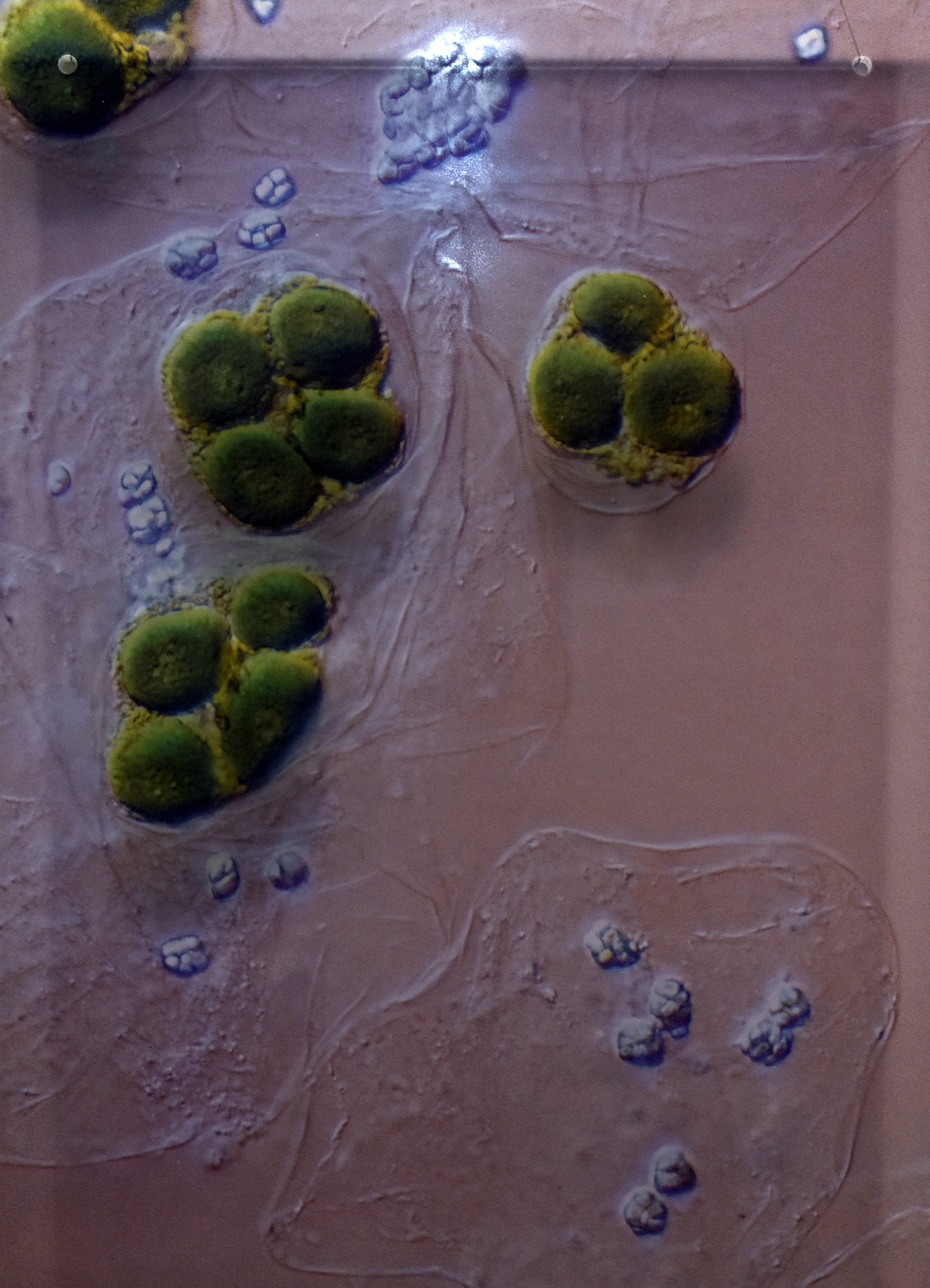
What was the inspiration behind your artwork?
Jane: My goal was to help Emily share her passion and research on chloroplasts with the general public.
Why is science-art important in today’s society?
Jane: Artists and scientists thrive from understanding something new, solving problems, sharing results, and advancing community knowledge. They embrace the idea of experimenting, risk-taking and inquiry. They look at the world from a different perspective, think critically and use “out-of-the-box” strategies to explore issues and ‘‘big questions”. Through art, scientific ideas and findings can become accessible to a larger audience. The sharing of creativity and inquiry between scientists and artists can also open up possibilities on how to approach scientific problems and how to share this knowledge with the general public.
What did you learn from this initiative?
Jane: I didn't need to capture the images myself in order to participate in this project. Instead, I lent my skills in conceptualizing how to best present Emily's work in a way that engages and excites the public. It was important for me to incorporate her passion for this research into the final piece and to bring her message to light.
Links: Jane's website

 SciArt Creators // M. Hossein, M. Kouhani & Stephen Kelly
SciArt Creators // M. Hossein, M. Kouhani & Stephen KellyAction Potential is an electro-mechanical sound and light installation generated by a programmed neural network of 6 Neuromimes. In this prototype, each neuron’s membrane, or action potential is represented by an air volume in a colored balloon. LED stripes trace the flow of spikes across the network.The Neuromime is an electronic model of a biological nerve cell, completed with dendrites and axons that can be infinitely inter-connected to create site-responsive electro-physical artworks. As muscles in a body physically articulate neurological function through gesture and voice, the behaviour of the network is expressed through pulsing patterns of sound, light, and motion.
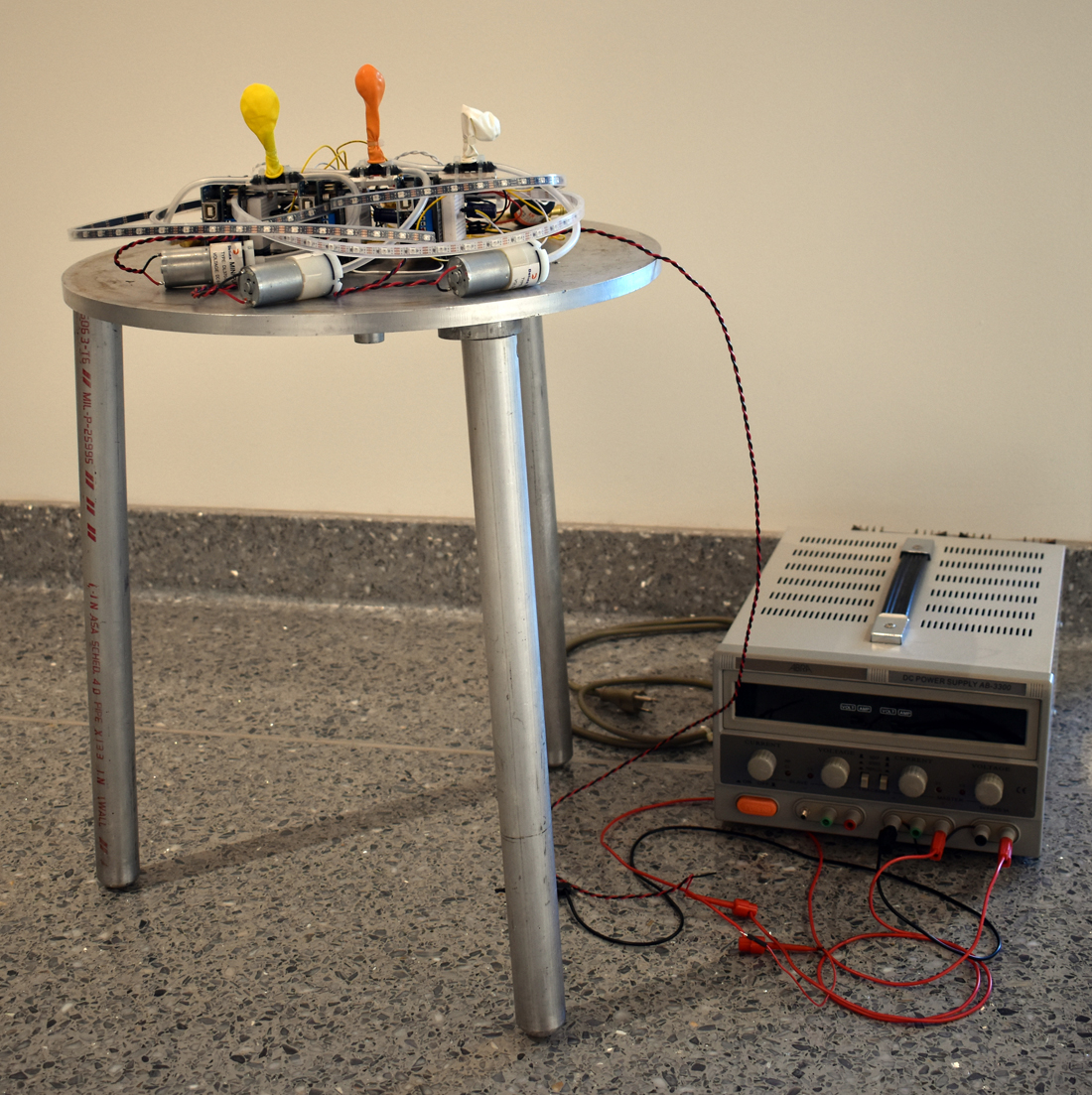
 SciArt Creators // Anastasiya Lavell
SciArt Creators // Anastasiya LavellThe Chemists is a simple work illustrating commonplace ornamental flowering plants, ones that could be encountered easily in daily life. This work's goal is to bring to light the complex chemistry that goes on in many plant species. Today's society tends to associate "chemicals" with synthetic and man-made compounds, and does so in a negative light. Meanwhile the term "natural" is synonymous with good and positive compounds. The reality is that plants are capable of incredibly complex chemistry, creating compounds that aid in industry, heal sicknesses , and also have the power to take lives. While we continue to learn about plant biochemistry, much remains to be learned from these accomplished chemists of nature, and they deserve our attention and respect.

What was the inspiration behind your artwork?
Anastasiya: I love growing various plants at home, and one thing that goes by under appreciated is the incredible array of chemical compounds made by plants including ornamental flowers. I wanted to bring forward the power of chemistry behind the aesthetic front of ornamentals. There are too many to choose from, but I picked several members to represent their families, which produce compounds that can be used in commodity goods, repel pests, produce medicine, or even be a death sentence. Flowers are often overlooked as only pretty, but we should always remember their power in chemistry.
Why is science-art important in today’s society?
Anastasiya: I think humans are imaginative and we use emotions to relate concepts to our own lives. Science can be a challenging area for many because it really doesn't evoke any specific emotions and relating to something like that can be extremely difficult. Art has a way of evoking emotions in people, and it could inspire people to relate to scientific concepts that would otherwise fail to stir the heart of humanity.
What did you learn from this initiative?
Anastasiya: I can reach non-scientists as well as scientists through art.
About Anastasiya: Anastasiya Alexandrovna Lavell, PhD Candidate in Biochemistry and Molecular Biology
Links: LinkedIn
 SciArt Creators // Siobhan Cusack, Bethany Moore, & Juanita Baldwin
SciArt Creators // Siobhan Cusack, Bethany Moore, & Juanita BaldwinSpecialized metabolites (SMs) are molecules found only in specific lineages of plants, and perform a myriad of functions that allow the plant to interact with its environment. In plants, SMs include examples like acylsugars in wild tomato which trap small insects, like whitefly, by preventing the insect from feeding on them. Caffeine, found in a few different species like coffee, attract and retain pollinators by helping the insect remember where the flower is. SMs are highly diverse across species, and actually outnumber the amount of compounds which are common to all plant species, such as metabolites related to photosynthesis. Despite the importance of SMs, the majority of genes that encode proteins which make these compounds have not been identified. The author’s research project uses computer science to predict which plant genes make SMs. The artists would like to convey an abstract version of how these molecules are encoded by genes which are found using computer models, and how they fit into the larger picture of complex interactions among plant and animal members of Earth’s ecosystem. A phylogenetic tree in the center shows the divergence of many plants and each plant has its own SMs that are encoded in its DNA. The clay leaves by each plant hold a scent made by its respective plant, and the molecules surrounding it is the chemical structure of that scent.
What was the inspiration behind your artwork?
Juanita: My teammates, Dr. Bethany Moore and doctoral candidate Siobhan Cusack designed the piece based on their science studies and research.
Bethany: This work is inspired by my thesis work on identifying the genetic basis of specialized (lineage-specific) plant metabolites.
Why is science-art important in today’s society?
Juanita: It opens a window to the non-scientific world to explore and understand a new universe of knowledge.
Bethany:Communicating science is always important for people to understand the importance of federally funded science. I think art captures a wide audience, perhaps those not initially drawn to science. Art may be able to spark wonder and amazement at aspects of science not immediately evident to the greater public.
What did you learn from this initiative?
Juanita: I learned that science is like a new challenging language that I do not master.
Bethany: That art has parallels to science in ideas, scope, practicality, testing, and results. Artists must test and try things in order to get a piece to "work", much like scientists must test and try hypotheses to see what will happen. Like science, art is a process that builds on other work but the result is novel.
About Juanita: Juanita Baldwin - Artist (painting and fine art photography)
Links: Website
About Bethany: Bethany Moore, scientist, phD in Plant Biology
 SciArt Creators // Dr. Mark Reimers, Ryan Aridi, Maegan Kornexl, Kylie Smith, and Lili Gloe
SciArt Creators // Dr. Mark Reimers, Ryan Aridi, Maegan Kornexl, Kylie Smith, and Lili GloeA translucent life-size plastic head dynamically illuminated (slowed down five times) to illustrate brain activity as a person becomes conscious, and forms a lasting impression, of an experience.
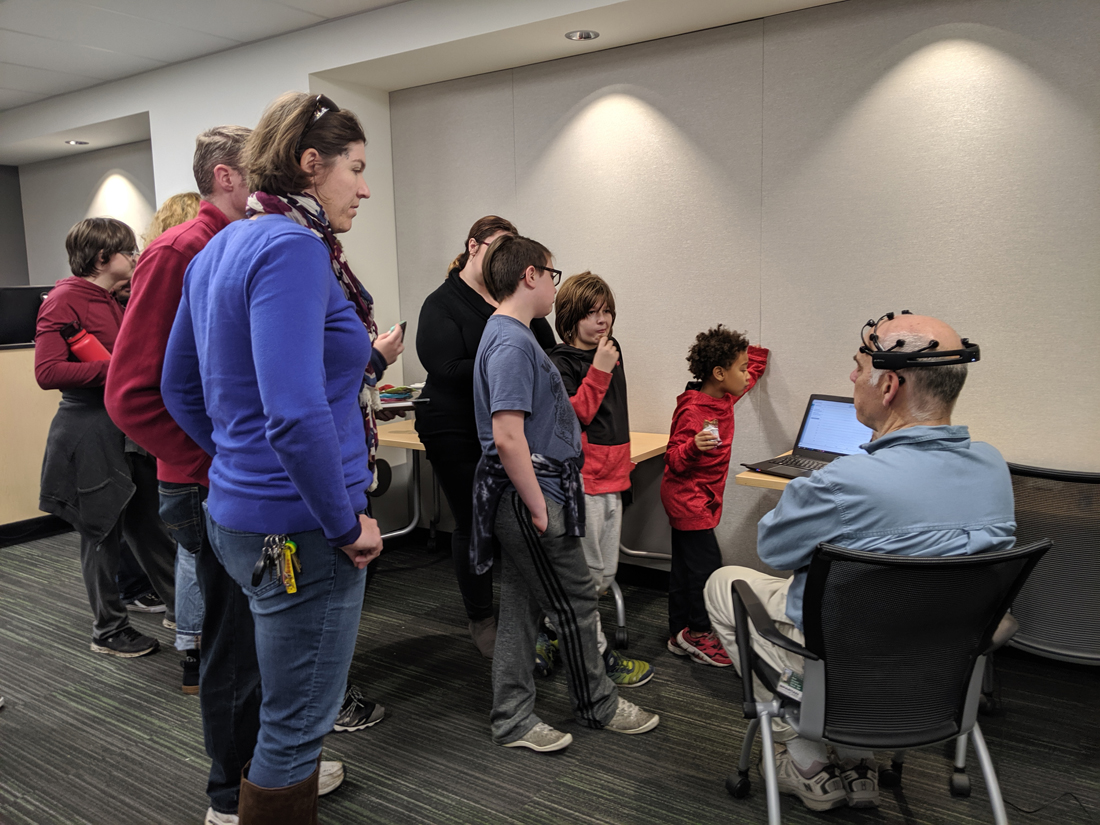
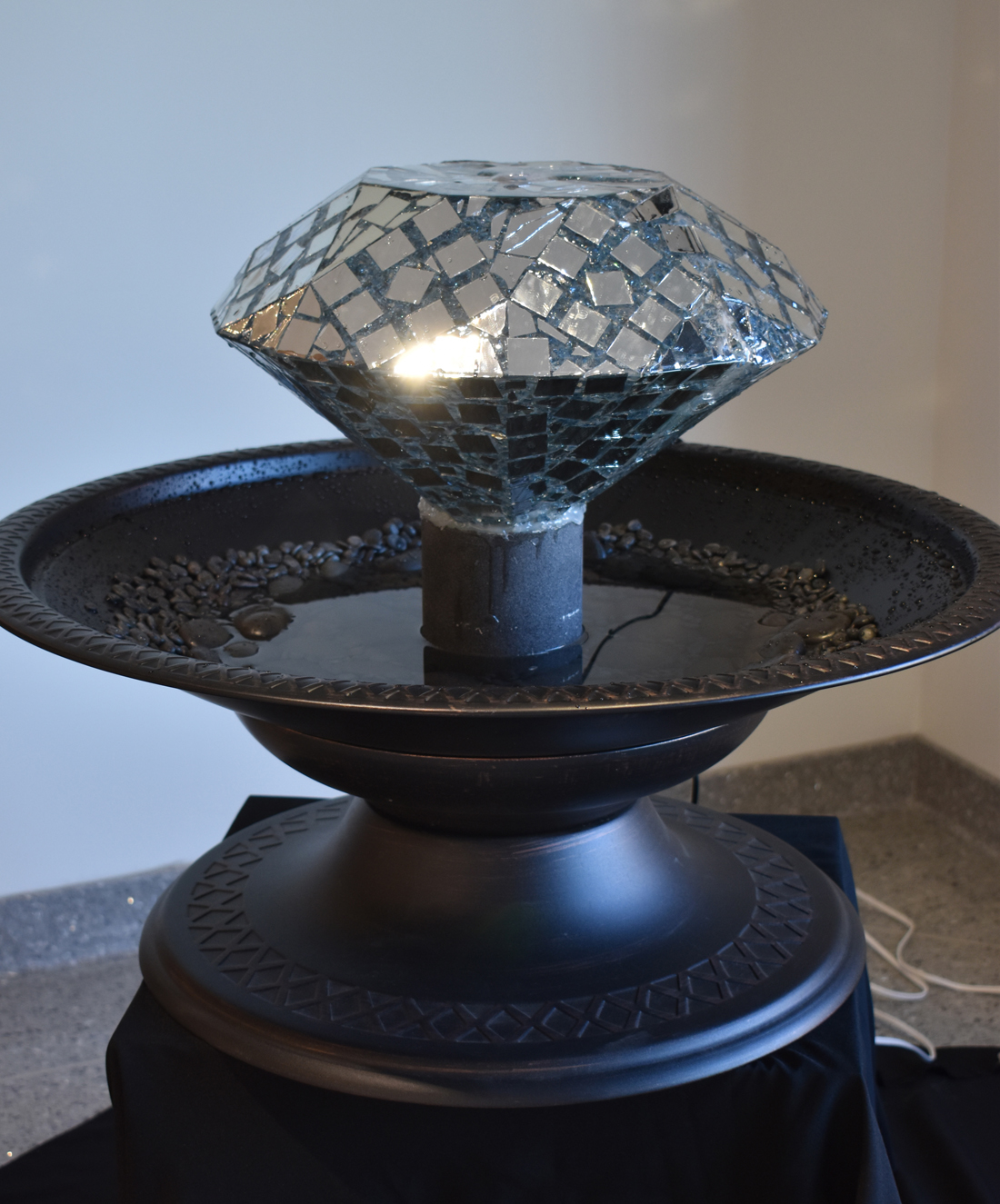 SciArt Creators // Mary Ensch & Lexi Rogien
SciArt Creators // Mary Ensch & Lexi RogienThe Big Blue was created by Ensch and Rogien to shed light upon the scientific uses of diamond by drawing attention to its typically portrayed gemstone appearance. With the incorporation of the color blue, the boron doping process performed during deposition is visually realized. Sitting atop black stones, the gemstone appearance is supported by the physical nature of diamond as a thin film coating. The water feature allows for water to flow over the diamond’s surface as it would in a water treatment application.
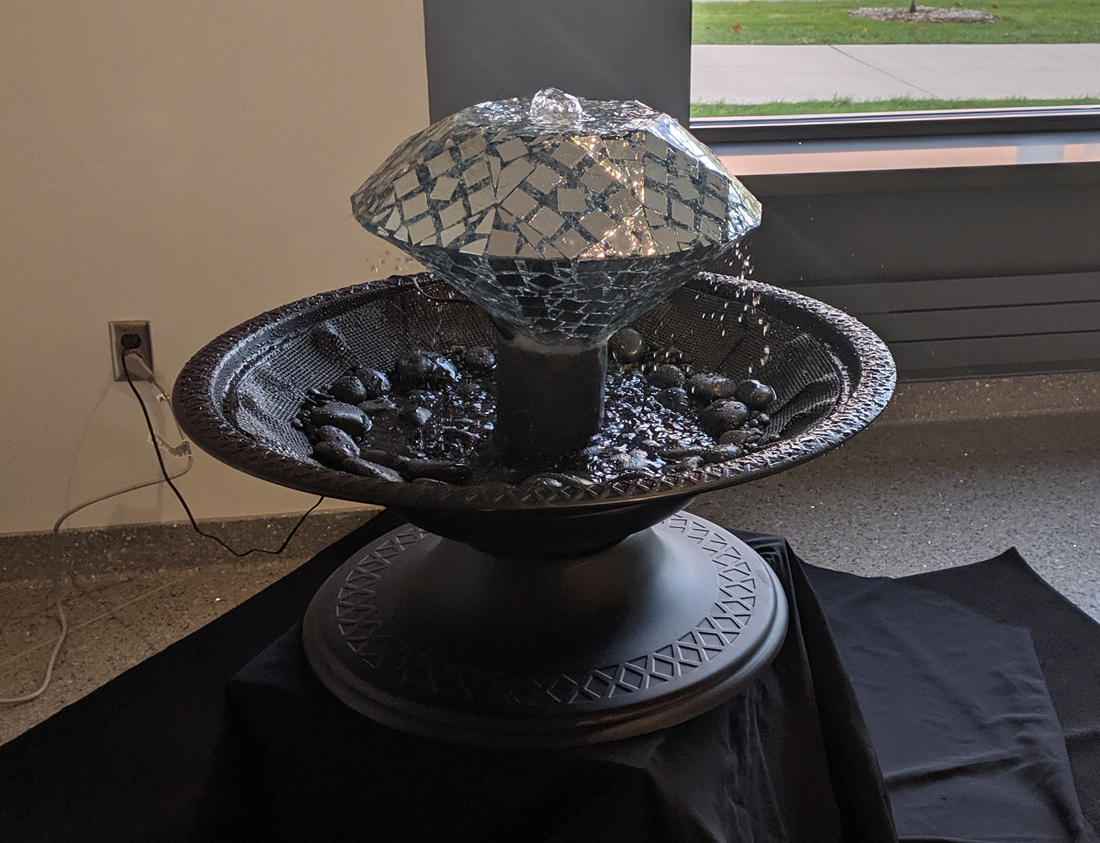
What was the inspiration behind your artwork?
Mary: This work was inspired by the scientific use of diamond films in the application of water treatment. We wanted to attract people's attention with the typical gemstone appearance of diamond and have them begin to ask themselves why water would be running over it and if this is an actual process in industry.
Why is science-art important in today’s society?
Mary: Science art is important in today's society to allow people to interpret science in a visual way instead of the typically written reporting. Science-art is important in being able to convey scientific knowledge to a broader audience. It allows more people to become interested in science where they may not have thought they would be previously.
What did you learn from this initiative?
Mary: From this initiative, I learned that there is no right or wrong way to convey your science as an art piece. It is all about having people become curious as to why the piece was created in the first place and starting conversations around it.
About Mary: Mary Ensch is a PhD student in chemical engineering at Michigan State University. She is currently researching wastewater treatment using electrochemical oxidation for the destruction of PFAS.
Links: LinkedIn
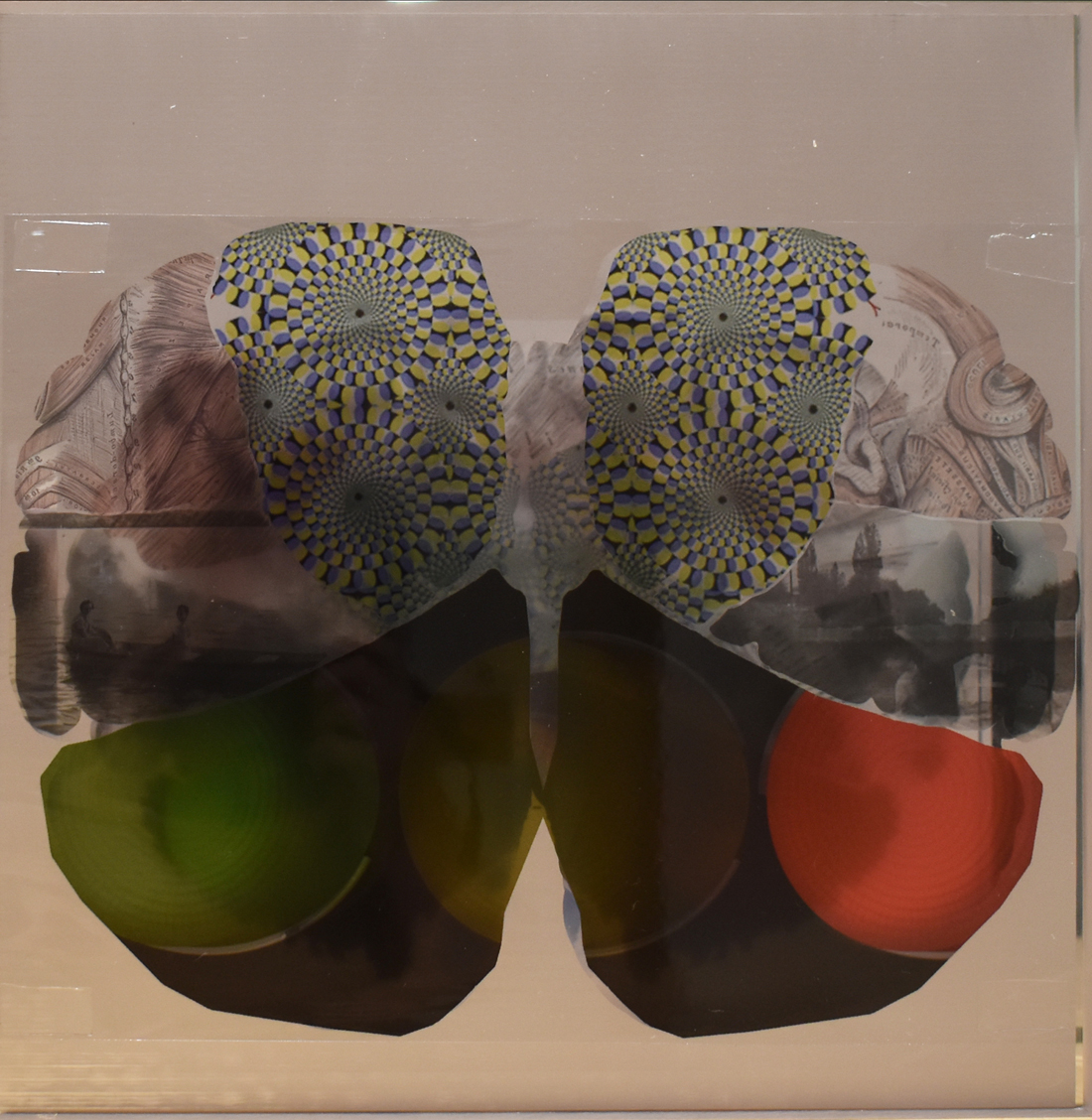 SciArt Creators // Erin McKay & Mei Kiengsiri
SciArt Creators // Erin McKay & Mei KiengsiriThe brain is more than a thinking machine. While a small organ, it controls, coordinates, and guides our behavior and senses in ways we take for granted. This piece serves to illustrate the pairing of these roles to discrete brain regions while encouraging a self-guided tour. The piece also draws inspiration from references used by scientists such as the Allen Brain Atlas to give viewers a glimpse and appreciation for such study. The intent is that viewers will consider the role of their brain in their life while examining the piece.

 SciArt Creators // Corinn Rutkoski
SciArt Creators // Corinn RutkoskiMicrobes are microscopic organisms that are omnipresent in the environment. Despite their miniscule size, microbes are a powerful driving force behind important ecological processes. Each ecosystem on Earth hosts a unique assemblage of microbial life that has evolved to carry out specific functions. To study these unseen wonders, researchers can culture individual strains of microbes by allowing them grow on small round petri dishes. Each strain displays a unique shape and color. Here, arrangements of beads on petri dishes are used to portray the diversity of visual form produced by microbes when they are cultured in the lab.
 SciArt Creators // M. Hossein M. Kouhani & Alexia Witcombe
SciArt Creators // M. Hossein M. Kouhani & Alexia WitcombeThere is a tree inside each of us made of squishy pyramidal cells called the nervous system. Nerve cells branch out and link to each other with repetitive self-similar fractal patterns also seen in plants, as well as snowflakes, river channels, and electricity discharged in non-conductive materials. In this case, we observe this similarity with a humanoid organism who develops thoughts and emotions through the flattened dendrite branchlets of an arborvitae that happens to photosynthesize and to take up water and nutrition from the soil. Soil supports and sustains plant life and, by extension, human life. Human life depends on soils not only for their critical role in food and biomass production, but also for other essential ecosystem services such as water filtration, carbon storage, and the antibiotics to fight disease. Soil is alive, and similar to the human biome, it is populated by multitudes of microbes. The human microbiome in its entirety contains an estimated 30 to 50 trillion bacterial cells, whereas a single gram of soil is estimated to hold up to 10 billion bacterial cells. The “black box” of soil microbes becomes less opaque as our understanding of soil life and diversity continues to expand.

 SciArt Creators // Mei Kiengsiri, Marissa Grobbel, Chelsie Boodoo, and Connor Boss
SciArt Creators // Mei Kiengsiri, Marissa Grobbel, Chelsie Boodoo, and Connor BossBladder dysfunction is an often overlooked, but surprisingly common condition. A neurogenic bladder can be caused by any type of neuropathy resulting from diseases and injuries such as spinal cord injuries, diabetes, spina bifida, or multiple sclerosis. When a person loses the connection between their nervous system and urinary bladder, this can cause remodelling which results in a disruption to the healthy voiding process. This causes symptoms such as urgency, incontinence, and discomfort. The purpose of this art piece is to bring awareness to this understudied dysfunction.

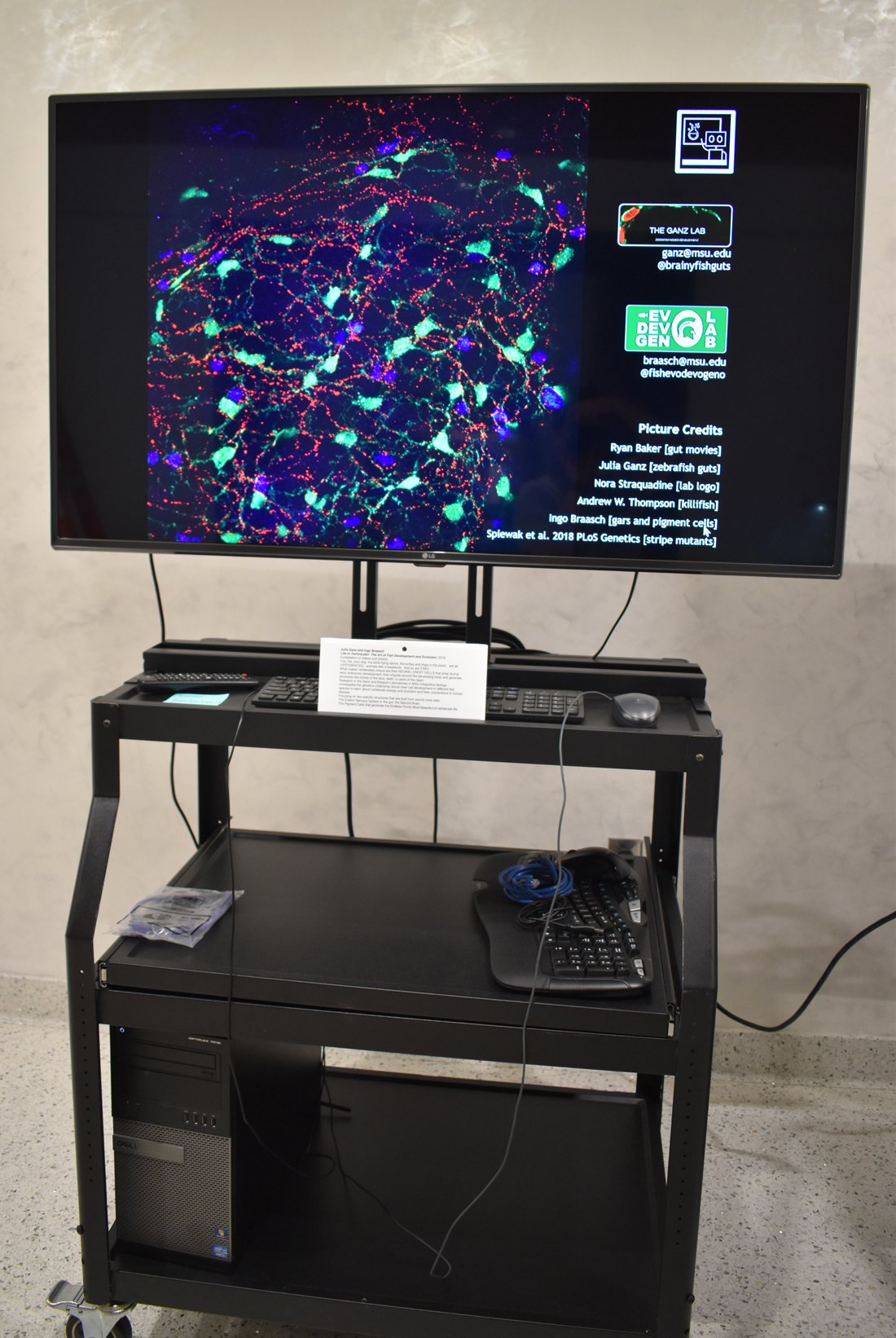 SciArt Creators // Dr. Julia Ganz and Ingo Braasch
SciArt Creators // Dr. Julia Ganz and Ingo BraaschYou, me, your dog, the birds flying above, the turtles and frogs in the pond... are all VERTEBRATES - animals with a backbone. And so are FISH! What makes vertebrates unique are their NEURAL CREST CELLS that arise during early embryonic development, then migrate around the developing body and generate structures like bones of the face, teeth or parts of the heart. Research in the Ganz and Braasch Laboratories in MSU Integrative Biology investigates the genetics underlying neural crest cell development in different fish species to learn about vertebrate biology and evolution and their connections to human disease. Focusing on two specific structures that are built from neural crest cells: The Enteric Nervous System in the gut; the Second Brain. The Pigment Cells that generate the Endless Forms Most Beautiful of vertebrate life.
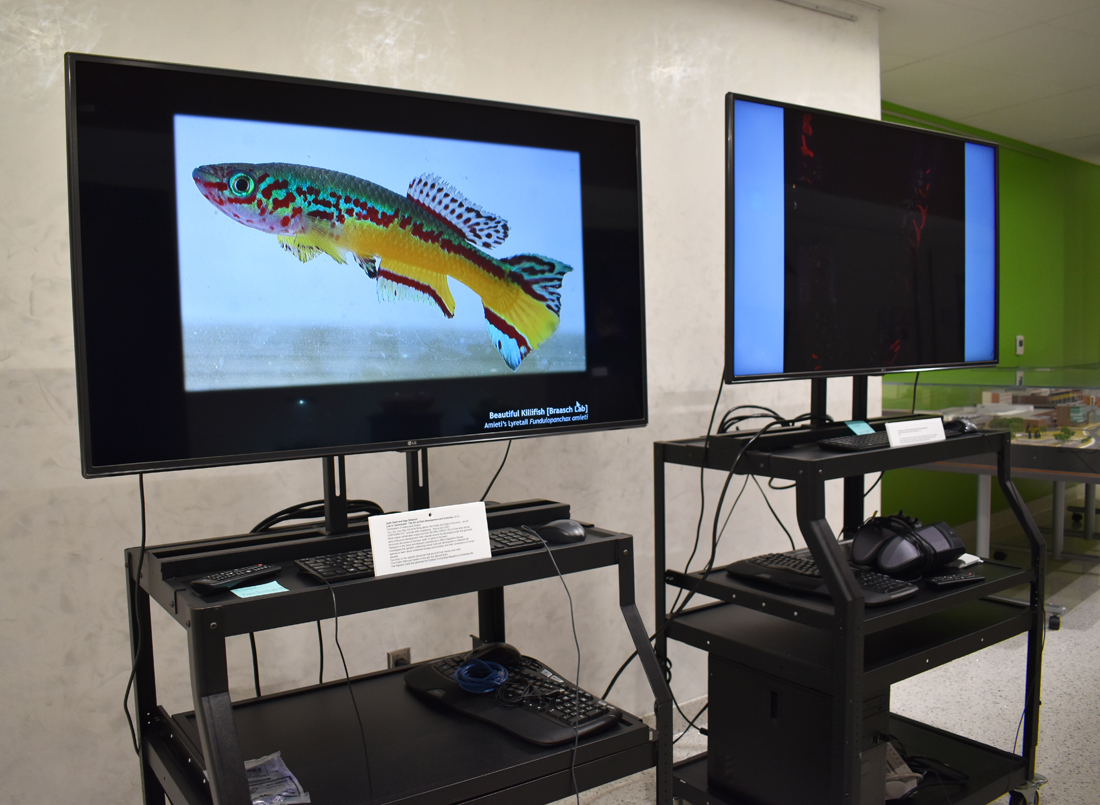

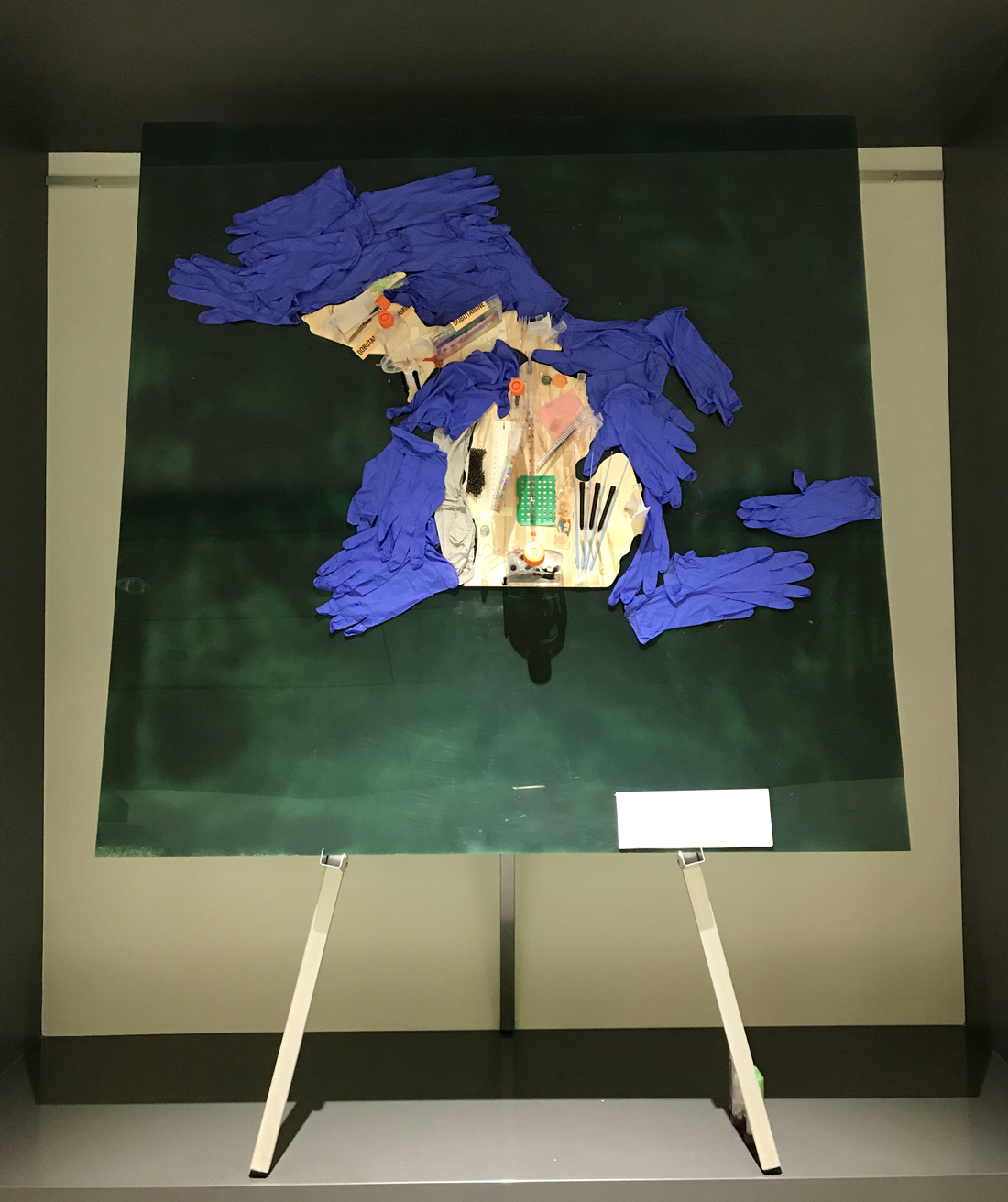
A homage to the Spartans Will boards all over campus, this piece features a thin green acrylic background with a light colored wooden Spartan helmet. This helmet is decorated with many types of lab materials, from pipette tips to goggles. Scientific research is an amazing part of MSU's campus, and this piece is dedicated to all researchers. Take a picture under the Spartan Helmet, because science is beautiful.
Michigan has a thin green acrylic background with a light colored wooden cut out in the shape of Michigan. Lab materials decorate the wooden area; including 50mL conical tubes, painted slides, black pipette tips, clear cell culture flasks and more. Surrounding Michigan are blue nitrile gloves representing each of the 5 great lakes. This piece shows the beauty that can be found in science, contradicting the stereotype that science is sterile and cold. It also is meant to draw attention to the amazing scientific research going on in our beautiful state.
What was the inspiration behind your artwork?
Chelsie: I wanted the public to be able to feel connected to science through art. The spartan helmet and the Michigan Map made with the lab equipment is a way to promote science within Michigan and see that science is a part of our lives.
Why is science-art important in today’s society?
Chelsie: Science-art helps scientists disseminate their data to a broad audience but also allow their audience to understand their concepts on a deeper level. Words do not always do justice to a scientific process and through art we can inspire and teach while entertaining people and grasping their attention.
What did you learn from this initiative?
Chelsie: This initiative taught me how to interact with artists. I am used to communicating with scientists but I have not spoken to many artists before. I learned how the art department works and the different classes that are offered. I also learned more about construction and different glues that are needed for different materials.
About Chelsie: Chelsie Boodoo, Biomedical Engineering Ph.D. Student at Michigan State University, President of MSU SciComm and co-host of The Sci-Files on Impact 89FM
Links: Twitter
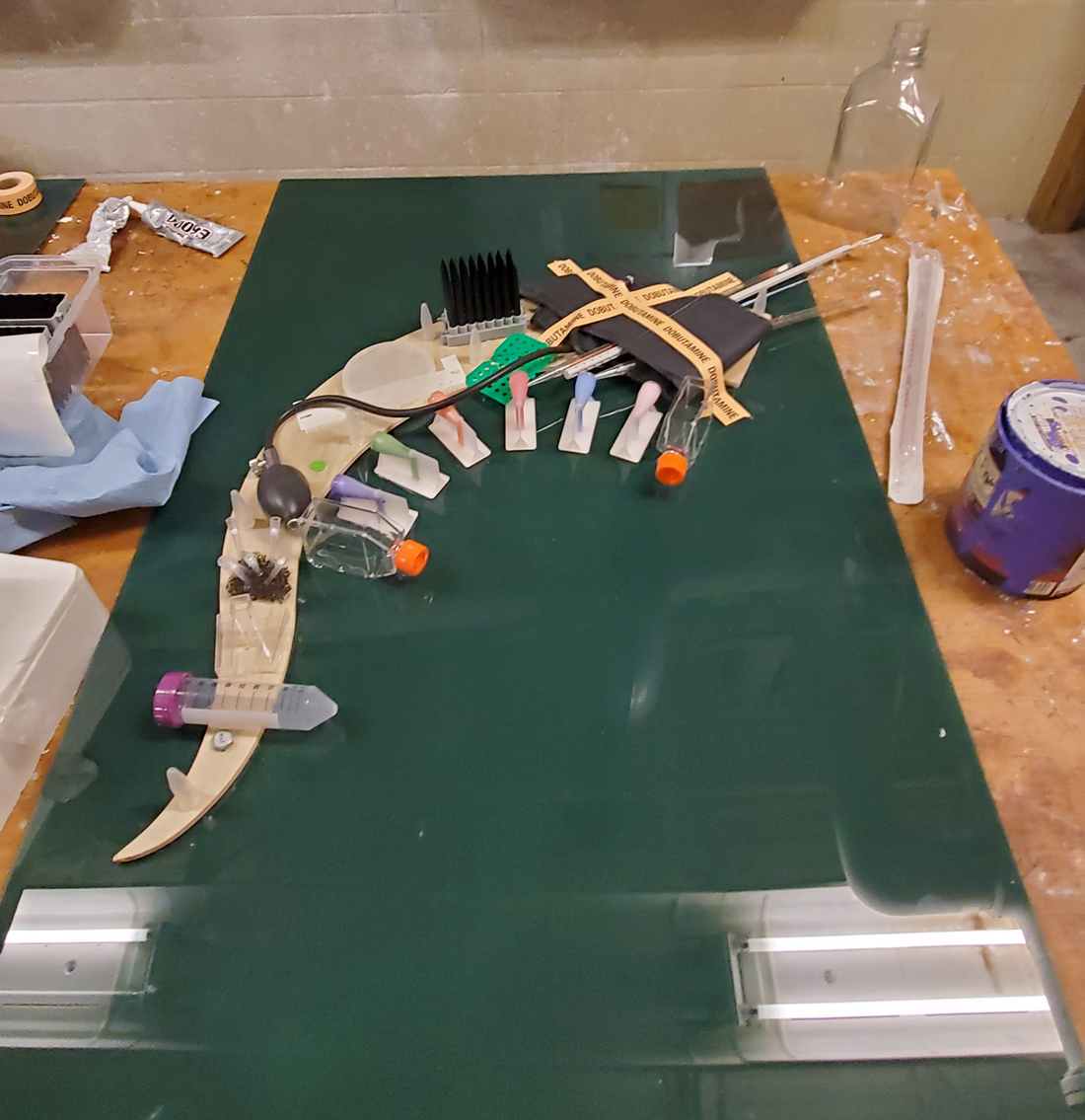
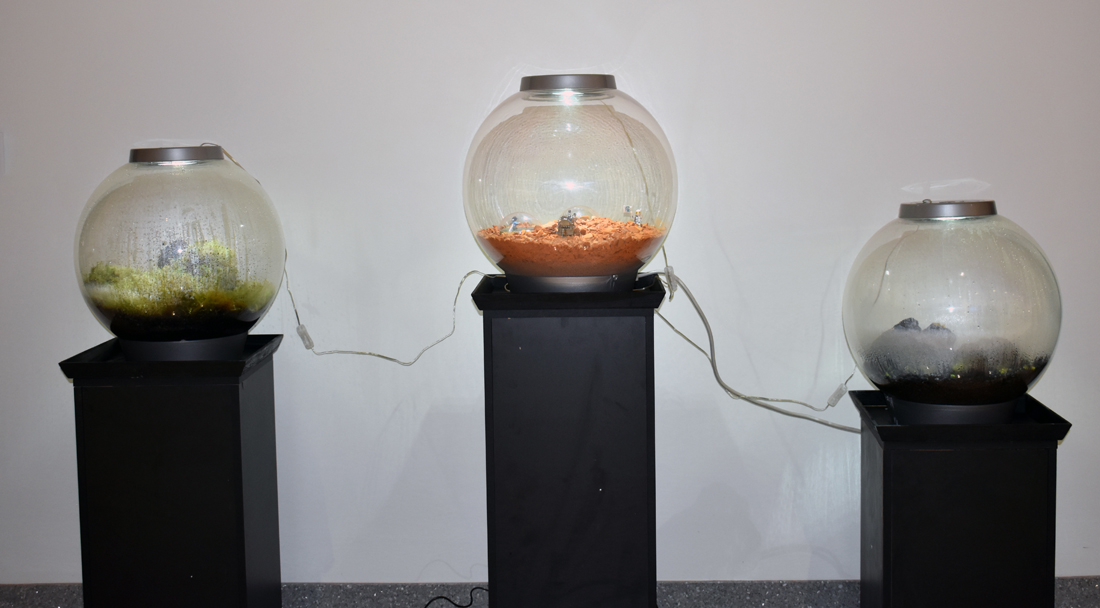 SciArt Creators // Drs. Sarah Evans, Gregory Bonito, Björn Hamberger; collaboration w/ Jj Kidder | Realization: Davis Mathieu, Abby Bryson, Britta Hamberger
SciArt Creators // Drs. Sarah Evans, Gregory Bonito, Björn Hamberger; collaboration w/ Jj Kidder | Realization: Davis Mathieu, Abby Bryson, Britta HambergerLife emerged in the oceans. Fungal symbionts and their photosynthetic hosts pulled off the ultimate coup, claiming the land as their new habitat. This experimental installation features a time series of habitats, inoculated with one of the most ancient lineages of land plants. The first land plants were not alone in making the step from water to land. Microbes provided critical support. Simulating such an early terrestrial ecosystem, daily fog carrying spores of a primordial lineage of fungi, inoculates the soil. Observe how the new space is colonized! The project intends to fuel discussions about deep space exploration, terraforming, and synthetic biology.
In part supported by NSF Dimensions of Biodiversity and the Great Lakes Bioenergy Research Center.
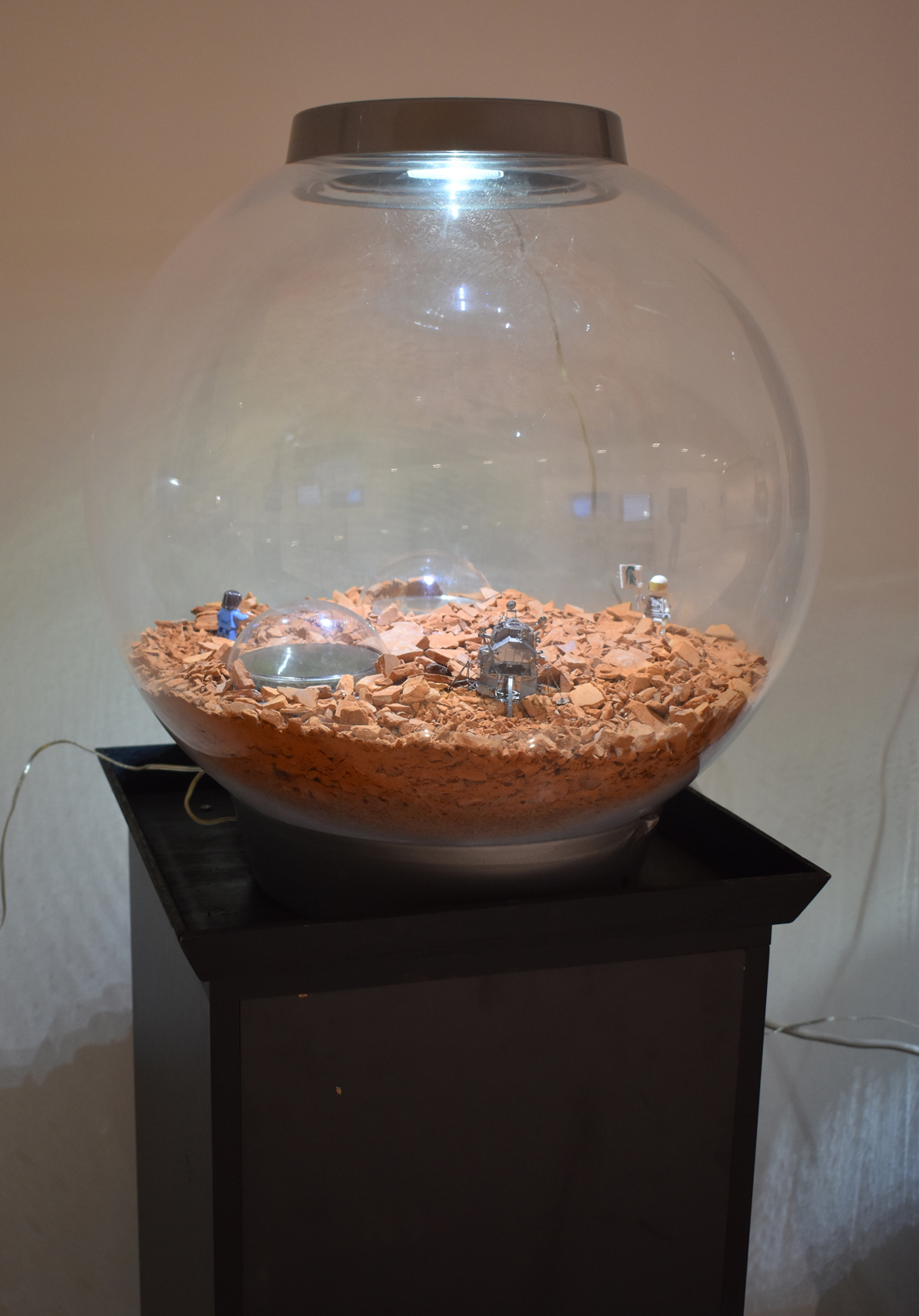
What was the inspiration behind your artwork?
Björn: Excellent chance to trigger public communication about plant synthetic biology. How do you translate the complex science behind the research of plant-microbial interactions to the public? Plant synthetic biology, a budding field holding possible answers for a future biobased, and not petro-oriented society?
Why is science-art important in today’s society?
Björn: As a means to develop much needed dialogue. Make the society understand the possible impact of science on our future. And inspire new generations with the approaches, solutions, silver bullets? Not yet. But the society can get an impression on the trends.
What did you learn from this initiative?
Björn: High motivation, enthusiasm. The public was far more open to receiving visions. Embracing new technologies which may provide solutions not alternatively possible.
About Björn: Dr. Björn Hamberger, Assistant Prof. in Biochemistry and Molecular Biology with research focus on Plant Synthetic Biology.
Links: Website
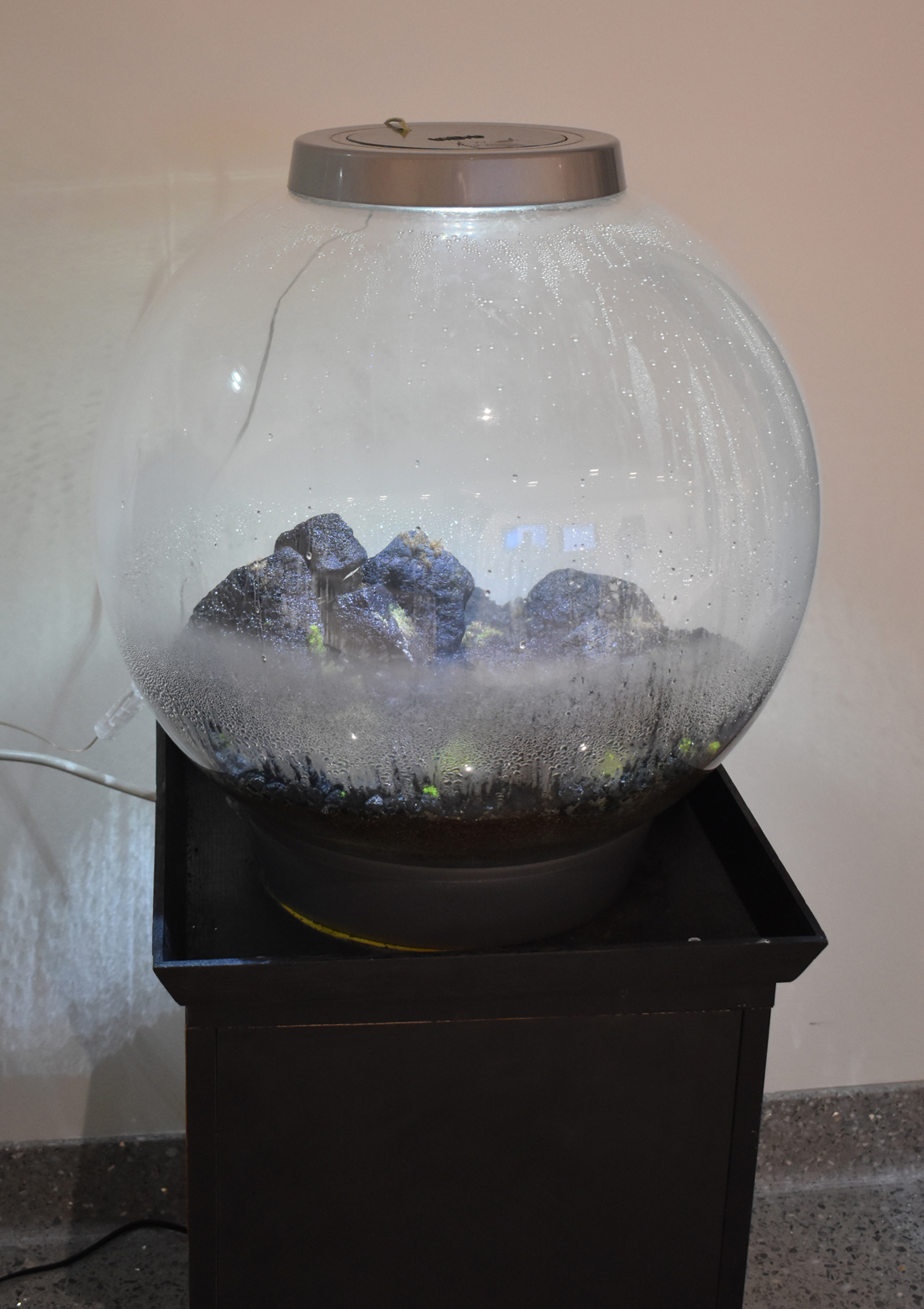
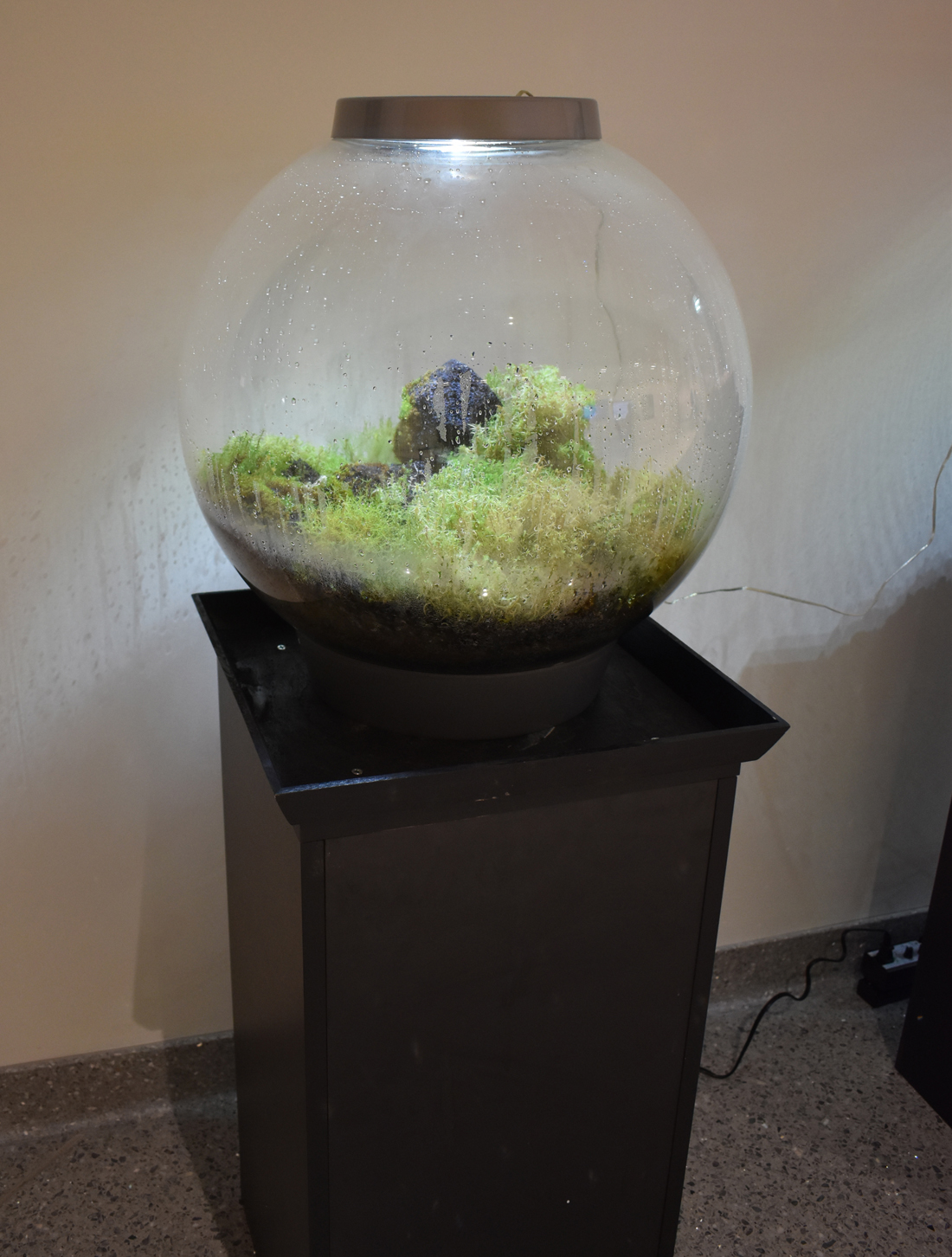
 SciArt Creators // Maris Polanco
SciArt Creators // Maris PolancoThis is a 1/10 scale model of ETERNAL by Maris Polanco, which was originally shown at Science Gallery Detroit in 2019 and soon to be shown at the National Academy of Science in 2020. The piece calls attention to the emerging crisis of plastic pollution in the world’s oceans. Non Degradable plastic bags float in the ocean tides, resembling a favorite snack of many large sea creatures: jellyfish. The consequences of such mistaken identity have made the news as whales and sea turtles are found on beaches, emaciated and full of plastic. The notorious longevity of plastic and the amazing longevity of certain jellyfish species make for an interesting, if not macabre, marriage of ideas.

What was the inspiration behind your artwork?
Maris: The miniature jellyfish sculpture shown at MSU was the proof-of-concept model for the larger sculpture. Its name, ETERNAL, refers to both the notoriously long life of plastic as an environmental polluter and the amazing "immortal" life cycle of some jellyfish species. The piece was inspired by several 2018 news reports of beached whales, emaciated and impacted with dozens of pounds of plastic bags and other trash in their stomachs. The choice of a jellyfish as the subject of the piece refers to the fact that these animals are favorite snacks of keystone ocean species like whales, and are likely the reason that whales eat plastic bags.
Why is science-art important in today’s society?
Maris: Traditional science communication is not inherently inclusive; laden with jargon and gate-kept by formal education, lectures and presentations are often inaccessible to those without a strong STEM background from early on. The value of scientific thinking as a philosophy is difficult to convey through homework and exams, but critical engagement is exactly the kind of skill our next generation needs.
Science-Art shows create an interdisciplinary space for creative science communication, technical artistry, and artful social/cultural commentary from a diverse set of voices. It allows participants and audiences to engage their creative and analytical minds to forge new connections between ideas and learn about the world through art both factual and emotive.
About Maris: Maris Polanco is a Detroit scientist, educator, and artist. She is a graduate of both MSU and University of Michigan, with a BS in Human Biology and a MS in Pharmacology. Maris made her art debut at Science Gallery Detroit with ETERNAL, a 60-foot hanging sculpture of a jellyfish made from plastic bags. She currently teaches biology and physiology at Henry Ford College and Wayne State University.
 SciArt Creators // Alyssa Kim, Maxwell Oerther, and Sasha Kravchenko
SciArt Creators // Alyssa Kim, Maxwell Oerther, and Sasha KravchenkoThis picture was produced from X-ray micro-computed tomography images. Raw images were used for scientific image analysis, and then were reused for artistic creation. The four phase components, soil minerals, particular organic matter, water, and gas, are presented using a series of color combinations to show the complexity and beauty of soil structure.

What was the inspiration behind your artwork?
Alyssa: I wanted to inform public of the beauty of the soil structure.
Why is science-art important in today’s society?
Alyssa: Science-art is important because art is an excellent way that science can communicate with public.
What did you learn from this initiative?
Alyssa: Creating art piece is fun!
About Alyssa: Alyssa Kim/ Plant Soil and Microbial Sciences/ Ph.D. Student
 OUR DONORS
OUR DONORS
Facility for Rare Isotope Beams
MSU Broad Art Lab
MSU Council of Graduate Students (COGS)
Impact 89 FM
Associated Students of Michigan State University
MSU BEST
MSU Surplus Store and Recycling Store
MSU Science Festival
Science Gallery
MSU Residential Housing Services
Grand Traverse Pie Company
Dominos
MSU Biochemistry and Molecular Biology
Ellis N. Brandt Chair in Public Relations Endowment
Office of the Senior Vice President for Research and Innovation
Institute for Quantitative Health Science and Engineering